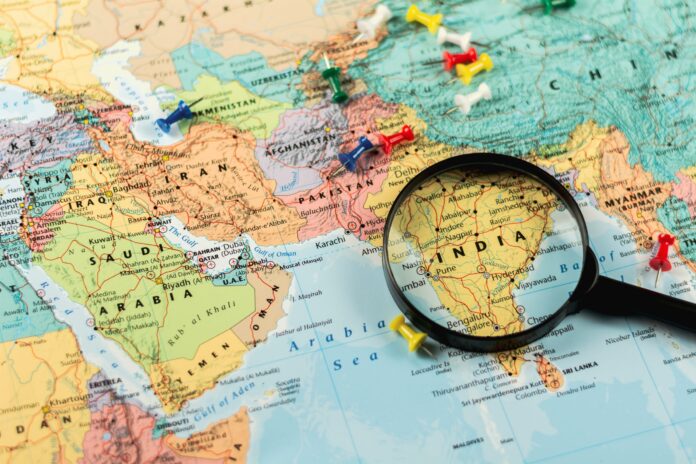By Dr. Sahibzada Muhammad Usman
Indian diplomacy is a worse example of countries’ strategies to achieve their goals. Pakistan has consistently been held accountable for the tense ties between the two bordering nations due to the aggressive diplomatic lobbying and media depictions by preceding Indian administrations. India continues to be South Asia’s favorite kid, despite the arrest of Kulbhushan Jadhav from Baluchistan, the violation of Pakistan’s airspace, and the Indian Air Force’s aborted effort to strike Pakistan in 2019.
India often blames Pakistan for disagreements, but when we look at its relationships with its neighbors, it becomes evident that Pakistan is not the problem; instead, it is India’s foreign policy toward its neighbors. India’s aspirations exacerbate conflicts in the area for expansion and insistence on playing the big brother role to smaller, weaker South Asian governments. Except for the Maldives and Bhutan, India has significant and minor wars with six of the eight nations with whom it shares a border. To determine that Pakistan alone should not bear the weight of tense relations, it is essential to evaluate the tensions between India and its neighbors.
The primary economic engine of South Asia has been Sino-Indian relations. However, in their quest to dominate the area, both countries have sometimes engaged in conflict, with the largest being the Sino-Indian boundary dispute over the Ladakh region. The Line of Actual Control (LAC) is not marked, often leading to infringement. The 1962 Sino-Indian war setback over the border issue was the first political snare the Indian government had to deal with. China saw the recent building of a road in the area as a challenge to the status quo and its strategic position in the region, especially in light of India’s intention in 2019 to eliminate Jammu and Kashmir’s long-standing autonomy and establish the Union Territory of Ladakh.
The border dispute is the main point of conflict between the two nations, but there are other problems as well. The Sino-Indian competition includes a maritime component to the nations’ navy build-ups and deployments in the Western Pacific and Indian Ocean Region (IOR). Beijing’s access to regional ports, notably with Pakistan, and its growing arsenal of blue-water naval weaponry, particularly submarines, are causes for concern in New Delhi over Beijing’s influence in the Indian Ocean. Beijing will remain cautious as New Delhi enters the nearby western Pacific waterways, despite its limited capacity to send naval assets there. Even if a conflict between China and India is still far off, their blue-water naval operations will continue to be marked by their competitive rivalry at sea, which is fueled by unresolved political concerns on land. Although there are strong economic linkages between China and India, problems are also becoming worse, with border disputes being the primary focus.
India was the first nation to recognize the Mujib Ur Rehman government and aid the Bengali-speaking people in their struggle against the ruling class of West Pakistan in 1971 when East Pakistan broke away from Pakistan and founded Bangladesh. However, when it comes to disagreements, India and Bangladesh often clash over territory, especially when it comes to water. The fact that the two states share 54 rivers makes it appear like they are playing a game of water squabbles.
Two significant bodies of water, one on the Farakka Barrage and the other on the Teesta River, are in contention. Despite the 1996 Ganga Water Treaty’s agreement to share Ganga waters, there are still differences in the Farakka Barrage’s construction and management by the Indian government. Bangladesh asserts that India releases an excessive quantity of water during the monsoons, which leads to flooding in the nation, and that it does not get a fair share of water during the dry season. The Teesta River provides irrigation to Bangladesh’s Rangpur district, and in 2011 a deal was made under which India would get 42.5% of the water, Bangladesh would receive 37.5%, and 20% of the water would flow freely. Even though these conditions have been met, the Teesta River still causes much trouble between the two republics.
India is Sri Lanka’s only neighbor with a sea border, and the two countries maintain close ties. Much has been written about India’s role in the civil war in Sri Lanka, but most recently, the two nations have been at odds over strategic matters and the issue of illegal fishing. The actual danger to India is the so-called “Sri Lanka-China Axis.” Despite having business connections to India, Sri Lanka has recently moved its attention to China. China and Sri Lanka signed a $1 billion agreement to develop a deep-water port at Hambantota. Later that year, the South Container Terminal in Colombo was constructed and run by a Chinese company. China started a 1.4-billion-dollar project at Colombo Port City in 2016 as a part of Beijing’s grand plan to construct a Silk Road through Asia. India plans to establish Trincomalee Port as a counterbalance to Chinese advances at Hambantota Port in order to offset China’s economic build-up in Sri Lanka.
Due to the fact that Nepal and India share an open border of over 1770 kilometers, the two nations have always enjoyed friendly ties. They have completed maps showing 98 percent of the line, but both nations have played a game over the Lipulekh pass, Kalapani, and Limpiyadhura in western Nepal.
When India’s Home Ministry published a new version of its political map, it made matters worse by including the contentious Kalapani area. Due to its role as a tri-junction between China, India, and Nepal, the Kalapani region is crucial from a geopolitical standpoint. Additionally, on May 8, 2020, the Indian defense minister effectively opened an 80-kilometer-long road in the Himalayas at the Lipulekh pass. In retaliation, the Nepalese government charged India with changing the status quo without consulting its diplomats. Kalapani, Lipulekh, and Limpiyadhura were included on a new political map of Nepal published by the government of Prime Minister Khadga Oli.
Consequently, the situation worsened, and troops from both sides of the border engaged in a standoff. Why Nepal, a landlocked nation that depends largely on imports from India, adopted such a rigid stance is a fascinating subject. China’s Belt and Road Initiative (BRI), which fills the gap with investments, loans, and assistance, has expanded to include Nepal. The Lipulekh Pass is particularly significant to India since it was utilized against China in 1962; after the humiliating loss, the latter is more anxious about the Chinese infiltration through that route. Right now, India is one of many countries exporting commodities to Nepal.
India’s antagonism against its neighbors says a lot about the state’s aggressive behavior and expansionist goals. They may act in conformity with their national interests in the area and with impunity by pursuing a program of aggressive diplomatic efforts and lobbying in regional and international organizations. India has adopted actions that have heightened hostility with other regional governments, not only Pakistan, in an effort to establish itself as the dominating force in South Asia. While maritime conflicts with Sri Lanka have a long history along with ethnicity concerns, territorial disputes with China have been more frequent in recent years. Bangladesh is still embroiled in the territory and water disputes, and the Modi government’s expansionist goals are straining its traditionally cordial ties with Nepal.
The weight of hostility and animosity lies entirely on Indian shoulders. It will not be alleviated until the BJP leadership thinks again about its foreign policy choices and expansionist goals in South Asia.
About Author:
Research Scholar and Academic; Ph.D. in Political Science at the University of Pisa, Italy. Dr. Usman has participated in various national and international conferences and published 30 research articles in international journals.






